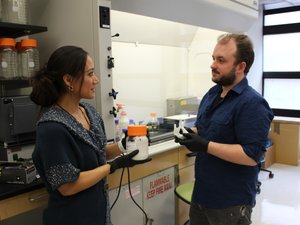
Can you scale an inspiring educator?
That's the question, and the motivation, behind just-launched Chicago-based edtech platform Hooray Learning, which is debuting its first service, Hooray Writing, this month. Born out of literacy nonprofit and bookstore Open Books, the platform offers multimedia writing prompts, story development help, and scaffolded (multistep) lessons that aim to rework the way kids think about writing, in a way that can set them up for success in and outside of school.
Previously this goal was orchestrated largely through Open Book's network of passionate educators. But as the need grows and the learning landscape shifts, Hooray Learning's cofounders hope this platform can provide a similarly dynamic education experience to a larger network of kids through technology.
At Open Books, where Hooray Learning CEO and cofounder Dustin Walsh previously served as the director of social enterprise, they would host writing workshops for kids, who came in with pretty much zero interest in the written word (and were pretty vocal about it). But once you put an amazing teacher in front of them who provided thoughtful prompts and engaging encouragement, students latched onto writing habits, Walsh explained.
"They come in hating writing, and they end up leaving really excited about it," he said.
But how do you expand this excitement beyond a bookstore? Walsh and Hooray Learning cofounder Stacy Ratner (the literacy entrepreneur behind Open Books and coworking space Literacenter) saw the potential in technology. About a year and a half ago, they got a grant to build out an initial platform that translated the most successful aspects of their writing programs to a web program, and started to test it with teachers and students. The feedback was good--so good that they decided to split this new venture out from the nonprofit fold, to create a for-profit social enterprise (though Open Books is a co-owner of Hooray Learning).
They were accepted to Impact Engine last winter and tested the product with over 3,700 students across the country, developing the platform as it was being actively used in classrooms (an unconventional technique, but one that Walsh said was key to ensuring the product actually worked for schools). Fresh out of beta testing, the Hooray Writing platform recently went live for student writers and educators.
"We focus on the creative aspect by providing interactive content within the platform," said Walsh. "Our goal is to get kids on the platform and writing within a minute."
Walsh considers the platform similar to Google Docs, in that it is built for collaboration. Students log onto the web-based Hooray Writing site and can choose from a variety of multimedia prompts and story creators-- everything from a mystery video clip to a DIY mad lib-- to get them started. From there, there are outline tools and choose-your-own-adventure style cues that can help keep kids engaged with writing for longer. The platform is two-sided, meaning teachers can get access to add their own prompts, and give feedback and motivation to students.
"[Students] need to feel excited and encouraged to express themselves and develop ideas," Walsh said.
The website is free and students can access it from home or in a classroom. Walsh said that teachers can onboard their students in just a few minutes.
Anecdotally, they have already seen motivation to write spike when their platform is introduced to a classroom. Walsh remembers during the pilot, one fourth grade class had a science fiction video writing prompt as an assignment just before Thanksgiving break. It was such a hit among elementary schoolers, that there were students who weren't from the pilot class logging in to access that video and write about it over the break.
Later this month they are introducing a parent subscription service that will serve as an initial source of revenue. That service will provide feedback for their child's writing from tutors and access to premium content. Down the road they are thinking of creating a subscription service for districts reports data and metrics, as well as platforms that bring their method other school subjects.
Translating education to tech is always tricky, especially for two people coming from the nonprofit literacy world. Walsh said there have been debates about what device to optimize for (web-based has proved the most accessible because there is no device standardization across schools) and how to ensure low-income students get access (they have provided tech products to their nonprofit literacy partners who are using the platform).
However, one of their biggest competitors is actually technology itself, he said. Students rush home to play on the Xbox or watch TV. They also might blog, without realizing that is a writing process. He believes that by making Hooray Learning exciting and engaging, they can help kids find a new use for their technology interest.
"What we're trying to do is repackage writing and make it exciting," he said. "By giving them the opportunity to use tech, they are more excited about it and they are writing without even realizing they are writing."








